Searching for cheap digs? Have a flat to rent? Use Brama's
FREE Classifieds:
Rentals/Real Estate
|
|
City Info & Fotos:
Crimea
Dnister River
Ivano-Frankivsk
Kharkiv
Kyiv
L'viv
Odesa
Ternopil
Resources:
Travel Agencies, ...
US Travel Advisory
Consulate Visa Info
Currency Convertor
News
Travel Tips Msg Board
Msg Board Policy
Maps/Distances:
Distance Charts
Road Mapper
Maps of Ukraine
Theme Fotos:
Busstop Shelters
Haystacks ...
Travel Essays:
Ukrainian Vacation
Six Days in Ukraine
Filer, Forbes ...
Country Info:
about Ukraine
UkraiNewstand
Weather Reports
Other Sources:
Links
by Jerome Simpson (1996)
| Introduction and departure from Budapest | Day 4: Yaremcha |
| Day 1: Lviv | Day 5: Yaremcha - Uzhhorod |
| Day 2: Lviv | Day 6: Uzhhorod |
| Day 3: Lviv - Yaremcha | Return to Budapest |
| Top of page |
INTRODUCTION
Since becoming independent in 1991, Ukraine has increasingly opened up to Western travellers. While cumbersome visa requirements still have to be met, the rewards from a visit to the region can be overwhelming. Lviv* on the one hand is a beautiful city in the heart of Western Ukraine that might well vie with Prague in years to come as the jewel of Central Europe. On the other hand, not overlooking the natural beauty of Zakarpattia (Transcarpathia), Uzhhorod knocks firmly upon Central Europe's door asserting itself as the crossroads to the East. Curious and hospitable, sleepy yet waking, Ukraine is one place that should be upon any intrepid explorer's itinerary and was upon mine during late August 1996. What follows below is an account of the experiences and impressions gained during a six day journey that took me through Western Ukraine and those places mentioned above.
* Transliterations of nouns and proper nouns are made from their Ukrainian spellings rather than from their former Russian names. The Government of Ukraine now requests these new spellings be used in English: Lviv (formerly Lvov), Kyiv (formerly Kiev), Uzhhorod (formerly Uzhgorod).
DEPARTURE: Sunday 18 August
Budapest - Grey overcast skies gave way to unbroken sunshine in time for my departure on the Lviv bound Tisza Express. Recalling Ukraine as one of those formerly hardline communist countries characterised by endless bureaucracy, unfriendly service staff, empty supermarket shelves and a polluted environment, not surprisingly I feel a little apprehensive "holidaying" in Ukraine. Nevertheless, boarding the train at 1615 from Budapest's Keleti Palyaudvar (East Station), a promising start was to be had with the compartment turning out to be rather cleaner than expected (though cockroach infested cabins might be more common, or so I am led to believe) and friendly carriage staff. And so settling down for the long 14 hour journey ahead, I could only begin to wonder what adventures lay in store during my forthcoming six days in Ukraine.
I didn't have to wait long. Approaching Zahony, the Hungarian border crossing at around 2100, the first challenge presented itself in completing the Deklaratsia or customs form - in Russian! Lonely Planet's Travel Survival Kit - Russia, Ukraine, and Belarus, an item invaluable on a journey like this offers practical advice on how to complete the form which requires everything be declared from watches to cameras and from walkmans to money - unless of course you are looking for it to be confiscated. After an hour's long wait, we roll slowly into Ukraine and soon after, border guards enter to make their routine inspections. Playing on the fact I don't speak Ukrainian seems to speed the formalities along nicely until one customs official gets picky and insists on seeing every one of my 360 US dollars (USD). One by one I lay them out and upon reaching 150 he nods his approval. Once authorised, the Deklaratsia should be stored safely until one's departure when again all possessions, including those purchased during one's trip, must be declared. A word of warning! Any items paid for in dollars and/or taken without receipt may also be subject to confiscation, though I'm intrigued to discover to what degree the rule in fact is enforced. I do eventually find out on the return trip that my 360 USD spent in Ukraine was not much of an attraction for the customs official.
The most exciting part of the journey might have been the changing of the train's wheels were it not for a visit paid in the early hours of the morning by a couple of bored border guards. Since the Russian rail gauge is some 24 cm wider than it's European counterpart, all rolling stock entering or leaving the Former Soviet Union has to undergo a time-consuming conversion that involves raising the cars some 2 metres above ground on hydraulic platforms, detaching the wheel truck assemblies, and rolling out the wheels from underneath and rolling in the necessary replacements. Usually this involves one hour or more of constant slamming and jerking, first as the train is shifted back and forth along the same piece of track while cars are separated, followed by a good half hour suspended above ground.
During the wheel changes, two young border guards returned to my compartment for an "off-duty" visit that included their attempting to tease 10 USD out of me. Old ways die hard it seems. Replying I had only Hungarian Forints, however, didn't seem sufficient to deter them, and after some 5 minutes pestering, I tried something a little more sentimental and produced a photograph of my 21 month old son. Realising at this point they were both getting nowhere, the guards stood up and left empty-handed. Although the money amounted to little by Western standards, had I given in, I could well have been entertaining a handful more border guards moments later. In the event, it seemed safer to avoid inviting further attention and refuse their requests. Any would-be traveller to the region should not, however, be put off. I think it rather adds to the journey's excitement than a holiday where everything goes (too well) according to plan.
Having been warned that once we pull into Chop (lying just inside the Ukrainian border) I am more than likely to be joined by a frenzy of excited and untiring locals involved in small cross-border trading, I put out all the lights and begin to fall asleep. Fortune must have been on my side since I am joined first by a middle aged woman, who while obviously a trader, seemed intent on getting some sleep, followed five minutes later by two soldiers, who, perhaps returning to camp after a weekend break, were also keen to bed down promptly. And so glancing around my compartment to ensure all my belongings were safe, I drifted off to sleep at around 0200 for what eventually was an uninterrupted night. Welcome to Ukraine! It was already beginning to live up to my expectations.
| Top of page |
DAY 1: Monday 19 August
click for full size
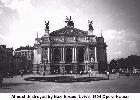 Lviv - Lying some 60 km east of Poland, Lviv (named after King Danylo's son
Lev, meaning lion) was founded as a Ukrainian hilltop fort in the mid-13th
century and, until emerging as the centre of Ukrainian nationalism toward
the end of the 19th century, was governed intermittently by both Poles
and Hungarians. Home also to the Ukrainian Catholic (Uniate) Church, combining
Orthodox ritual with Roman Catholic doctrine, the city re-emerged at the
end of the late 1980's in the vanguard of a powerful dissident movement
that eventually helped to realize Ukraine's independence from the FSU in
1991.
Lviv - Lying some 60 km east of Poland, Lviv (named after King Danylo's son
Lev, meaning lion) was founded as a Ukrainian hilltop fort in the mid-13th
century and, until emerging as the centre of Ukrainian nationalism toward
the end of the 19th century, was governed intermittently by both Poles
and Hungarians. Home also to the Ukrainian Catholic (Uniate) Church, combining
Orthodox ritual with Roman Catholic doctrine, the city re-emerged at the
end of the late 1980's in the vanguard of a powerful dissident movement
that eventually helped to realize Ukraine's independence from the FSU in
1991.
Arriving at 0700 under sunny skies, a taxi seemed the most convenient way of reaching the town centre. Smaller denominations of hard-currency cash prove invaluable at times like these and costing 3 USD to get to Prospekt Svobody (Freedom Avenue), the taxi dropped me near the immediately recognisable Ivan Franko Opera House. This turn of the century gem is lucky enough still to be standing owing to an undetonated bomb set by retreating Nazis at the end of World War II. Walking down Prospekt Svobody, (a long 600 metre tree-lined avenue), I head towards the Hotel George on Ploscha Mitskevycha, a busy intersection where a tall column stands fronted by the Polish poet, Adam Mickiewicz. The George (my base for the next few days) is an elegant turn of the century building which also houses a beautiful staircase that seems to evoke a bygone age, perhaps now a distant memory for most. Here a double room inclusive of breakfast costs just 16 USD per night (payment in hard-currency only). The shower facilities at the end of the corridor, while simple are adequate, and hot water is available, though the oftentimes low water pressure can result in no water at all. The George also has a U-tel phone installed and for 5 USD, a phone card can be purchased ensuring a fast and clear connection to any other destination in the world. I test it to be sure and indeed it's not hype. But beware, this does appear to be the only U-tel phone in Lviv.
click for full size
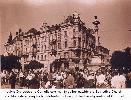 Emerging
from the hotel, one only has to walk a few steps before falling in love
with this beautiful city of some 800,000 inhabitants. Enjoying the extensive
old town centre and gazing at the beautiful architecture, I head for the
14th century Ploscha Rynok (literally translated means market square, hereafter
referred to as old town square), and a stone's throw away, the 65 metre,
triple tiered Kornyakt Bell Tower and majestic Dominican Church and monastery
with its huge dome, Lviv's finest example of 14th century rococo. Making
my way from the Armenian Cathedral, one of Lviv's oldest buildings with
sections dating back to 1363, I head for the compact 1609 Boyim Chapel
(of Hungarian origin), en route to the former Bernadine Church and Monastery
complex on Lviv's south side where the Orthodox and Catholic community
congregate en masse to celebrate the Feast of the Transfiguration of Our
Lord. The Ukrainian tradition is marked by the carrying of the fruits of
the season (usually apples) to church for blessing in baskets adorned with
flowers. Walking past the 1554 Town Arsenal (now the Museum of Old Arms)
and the Gun Powder Tower that make up part of the city's original fortification
system on the eastern stretches of the old town, I return to Prospekt Svobody
and the 1904 National Museum, once known as the Lenin Museum.
Emerging
from the hotel, one only has to walk a few steps before falling in love
with this beautiful city of some 800,000 inhabitants. Enjoying the extensive
old town centre and gazing at the beautiful architecture, I head for the
14th century Ploscha Rynok (literally translated means market square, hereafter
referred to as old town square), and a stone's throw away, the 65 metre,
triple tiered Kornyakt Bell Tower and majestic Dominican Church and monastery
with its huge dome, Lviv's finest example of 14th century rococo. Making
my way from the Armenian Cathedral, one of Lviv's oldest buildings with
sections dating back to 1363, I head for the compact 1609 Boyim Chapel
(of Hungarian origin), en route to the former Bernadine Church and Monastery
complex on Lviv's south side where the Orthodox and Catholic community
congregate en masse to celebrate the Feast of the Transfiguration of Our
Lord. The Ukrainian tradition is marked by the carrying of the fruits of
the season (usually apples) to church for blessing in baskets adorned with
flowers. Walking past the 1554 Town Arsenal (now the Museum of Old Arms)
and the Gun Powder Tower that make up part of the city's original fortification
system on the eastern stretches of the old town, I return to Prospekt Svobody
and the 1904 National Museum, once known as the Lenin Museum.
click for full size
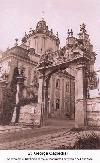 Any traveller will be interested to note Lviv's centre is not as polluted as
many other European cities and has a somewhat more relaxed feel, perhaps
owing to the fact a decent network of trams service the old town centre.
Many Lvivians use these rather than cars - and to its aesthetic advantage.
A less apparent delight resulting from Lviv's location a few degrees east
of Central Europe's emerging capitalism is it's dearth of cafeterias and
exclusive cosmetic, jewellery and fashion stores that today adorn the old
town squares of so many other Central European cities. In their place,
you can enjoy watching children play in the street and observe babooshka's
looking inquisitively down from their first and second floor flat windows,
while life below goes quietly on by.
Any traveller will be interested to note Lviv's centre is not as polluted as
many other European cities and has a somewhat more relaxed feel, perhaps
owing to the fact a decent network of trams service the old town centre.
Many Lvivians use these rather than cars - and to its aesthetic advantage.
A less apparent delight resulting from Lviv's location a few degrees east
of Central Europe's emerging capitalism is it's dearth of cafeterias and
exclusive cosmetic, jewellery and fashion stores that today adorn the old
town squares of so many other Central European cities. In their place,
you can enjoy watching children play in the street and observe babooshka's
looking inquisitively down from their first and second floor flat windows,
while life below goes quietly on by.
Spending the afternoon sitting in the Ivan Franko Park overlooking the prestigious 19th century University building, I head toward St. George Cathedral on top of one of the seven hills that overlook Lviv. This beautiful 18th century baroque building is currently undergoing extensive interior renovations and upon entering, all one sees inside is scaffolding. Returning to the centre of town and to what is known locally as the "Art Market" (just in front of the Ukrainian Drama Theatre), I negotiate a few bargains; two watercolours from a student of architecture for 17 USD and a couple of walker's maps that I hope will serve me well in Zakarpattia (the Ukrainian name for the Transcarpathian region that encompasses the west side of the Carpathian mountains and Ruthenia). Besides these items, one can also find old Ukrainian money, jewellry, books, and hand embroidered traditional costumes.
click for full size
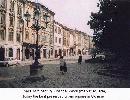 Heading
for the Old Rus' Quarter on the north side of the town, I find it one of
the less attractive parts of Lviv. The former old town square with its
origins lying in the 13th century, resembles something between a building
site and an overgrown park, currently being dug up for what appears to
be the installation of a sewer system. Thus retreating back to the comforts
of the old town square, I head for the Pid Levom (Under the Lion - the
lion being Lviv's symbol) restaurant at Ploscha Rynok 20 for dinner. Requesting
to see the menu (not usually given in case restaurants run out of food
- no kidding), I manage to decode the Cyrillic handwriting and order a
Chicken Kyiv and salad complemented by a not so cold beer. The dinner is
pleasant and costs some 2 million Kupons** or around 10 USD, though prices
do certainly seem to have risen since Lonely Planet last took a quote for
dinner here. Spending the evening strolling along Prospekt Svobody, I enjoy
watching the locals sell odds and ends (mostly maps, books, and Soviet
memorabilia that include cassettes of old communist anthems). Older generations
it seems prefer to discuss politics or sing folk songs beneath the nation's
favourite poet, Taras Shevchenko. Dusk falls late in this part of Ukraine
and as the evening slowly draws to a close, I return to the comforts of
the George thoroughly exhausted.
Heading
for the Old Rus' Quarter on the north side of the town, I find it one of
the less attractive parts of Lviv. The former old town square with its
origins lying in the 13th century, resembles something between a building
site and an overgrown park, currently being dug up for what appears to
be the installation of a sewer system. Thus retreating back to the comforts
of the old town square, I head for the Pid Levom (Under the Lion - the
lion being Lviv's symbol) restaurant at Ploscha Rynok 20 for dinner. Requesting
to see the menu (not usually given in case restaurants run out of food
- no kidding), I manage to decode the Cyrillic handwriting and order a
Chicken Kyiv and salad complemented by a not so cold beer. The dinner is
pleasant and costs some 2 million Kupons** or around 10 USD, though prices
do certainly seem to have risen since Lonely Planet last took a quote for
dinner here. Spending the evening strolling along Prospekt Svobody, I enjoy
watching the locals sell odds and ends (mostly maps, books, and Soviet
memorabilia that include cassettes of old communist anthems). Older generations
it seems prefer to discuss politics or sing folk songs beneath the nation's
favourite poet, Taras Shevchenko. Dusk falls late in this part of Ukraine
and as the evening slowly draws to a close, I return to the comforts of
the George thoroughly exhausted.
** From 2 September 1996 the "Hryvnia" was adopted as the new national currency of Ukraine. Its initial value was set at USD 1.75, and at the time of introduction was thus being traded at approximately 330,000 Kupons. Kupons were withdrawn from circulation on 16 September. The Hryvnia ( printed up in Canada) is named after the ancient coin that was used in Kyivan Rus'.
| Top of page |
DAY 2: Tuesday 20 August
Lviv - My second day is spent enjoying more of Lviv's natural and centuries-old beauty. Crossing the centre of town, I head up the Castle Hill (Zamkova Hora) for a 360 degree panorama of Lviv. Overlooking the old town, one sees spires, towers and rooftops that exude history and charm. To the east, hills stretch that far into the distance, and to the north, the newer and more industrial parts of Lviv. It seems the former communist authorities at least had the heart to leave the historical town centre untouched and build the less sightly parts outside. Kyiv, for example, is one Ukrainian city that was less fortunate.
Descending the hill toward the St. Paraskeva-Pyatnytsya Church lying on the far northern side of the town, its silver dome can be seen rising high above the roofs of surrounding houses. Having stopped in its grounds for less than a few minutes, I was pointedly ushered out by an old man, perhaps the caretaker, before getting a chance to look at the 17th century iconostasis inside. Originating from the end of the 13th century or the beginning of the 14th, the Church was originally constructed out of wood and can not easily be categorised under any architectural style. Containing elements of baroque, Renaissance, Moldavian, and Bukovinian, a series of tablets set into the walls inside explain the history of the Church and the man who funded the renovations (its reconstruction in stone), completed in 1645.
Taking the tram back across town and the number 7 bus out to the east, I head for Lychakiv Cemetery, a designated historic landmark since 1990. The Cemetery contains many fine monuments and sculptures of famous Ukrainians including another of Ukraine's favourite poets, Ivan Franko. Upon entering, I am arrested by an old lady requesting the entry fee of 300,000 Kupons (1.5 USD). While tour guides do exist I am quite content to wander around alone. Finding the monument and grave of Ivan Franko, I discover not much further away the impressive sculpture of a 1950's Olympic gymnast. "Absolute Champion" reads the text beneath.
click for full size
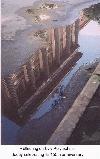 Returning
to the town centre, I head up Vulytsia Kopernika (Kopernika street) and
southwest into Lviv's outer districts. The buildings on either side of
the street appear to be of 19th-20th century origin and while old fashioned
Czech trams rumble up and down the hill, the sun sets gently behind. The
view prompts me to recall a photograph mounted in the
"Travel"
section of the BRAMA - Gateway Ukraine
(http://www.brama.com/) maintained by Max
Pyziur and Hanya Krill.
Of all the interesting buildings to be found, one on the north side of
the street resembles a miniature castle whose thick green ivy, in concealing
its large balcony and solid brick walls, looks like something lifted straight
from a fairy tale. Today, judging by the laundry hanging outside, however,
it appears to have been converted to small private flats. Heading back
down the street, a beautiful burgundy coloured building at the end of a
road away to the left turns out to be Lviv Polytechnic. Situated on Vulytsia
Bandery, this institution is also worth some minutes of any traveller's
time. The facade is made up of six solid beige columns which dominate the
entrance to the facility. Also considered to be one of the oldest academic
technical schools in Europe, it is currently celebrating 150 years.
Returning
to the town centre, I head up Vulytsia Kopernika (Kopernika street) and
southwest into Lviv's outer districts. The buildings on either side of
the street appear to be of 19th-20th century origin and while old fashioned
Czech trams rumble up and down the hill, the sun sets gently behind. The
view prompts me to recall a photograph mounted in the
"Travel"
section of the BRAMA - Gateway Ukraine
(http://www.brama.com/) maintained by Max
Pyziur and Hanya Krill.
Of all the interesting buildings to be found, one on the north side of
the street resembles a miniature castle whose thick green ivy, in concealing
its large balcony and solid brick walls, looks like something lifted straight
from a fairy tale. Today, judging by the laundry hanging outside, however,
it appears to have been converted to small private flats. Heading back
down the street, a beautiful burgundy coloured building at the end of a
road away to the left turns out to be Lviv Polytechnic. Situated on Vulytsia
Bandery, this institution is also worth some minutes of any traveller's
time. The facade is made up of six solid beige columns which dominate the
entrance to the facility. Also considered to be one of the oldest academic
technical schools in Europe, it is currently celebrating 150 years.
As the night draws to a close, I head for the Grono (Georgian) Restaurant, which can be found at the top of the Ivan Franko Park. Dinner comprises three courses, the first including a variety of sliced cold meats and minced meat rolled in cabbage leaves. The second course, a mild borsch tastes more like tomato soup, while the third consists of minced meat, this time mixed with rice and rolled in dark green leaves of kale flavoured with rare spices. The dinner costs just 920,000 Kupons or around 5 USD, though little was I to know of the discomforts it would later cause me. Heading back to the George, I consider tomorrow's venture into the Carpathian mountains and decide on taking a train to Yaremcha lying just inside the Carpathian State National Park. Yaremcha is the traditional centre of the "Hutsuls", a regional ethnic group known best for their folk crafts and unique wooden architecture, while the Park is one of the most densely forested areas in Eastern Europe, with the Carpathian mountains concentrating approximately a third of Ukraine's forested resources. The train I understand leaves for Rakhiv at about 1330.
| Top of page |
DAY 3: Wednesday 21 August
Lviv-Yaremcha. Rudely awakened in the early hours of the morning by a series of nauseating stomach cramps, my immediate concern was actually whether I would be able to make it to Yaremcha at all. A glass of mineral water and, needless to say, a few trips to the bathroom, temporarily resolved my discomfort though still suffering from what felt like a rough hangover, I slept only lightly 'til dawn. Following a light breakfast I headed for the travel bureau located just inside the George's reception, which is open to travellers looking to book both domestic and international rail tickets. Requesting from the English speaking staff a single ticket on the 1330 train to Yaremcha, the staff responded with a series of almost professional blank looks. Convinced the service doesn't exist, it takes a phone call to the main railway station to assure the train does run and actually departs at 1354.
With just a few hours to spare before departure, I take some time to visit friends at "Eco-Pravo", located in the centre of the Ivan Franko Park. Eco-Pravo is an independent, non-governmental organisation that deals with the legal aspects of environmental protection and is dedicated to raising the awareness of environmental and legal issues among lawyers, citizens and NGOs in Ukraine. Well established on the Internet they can also be found under the URL; http://www.igc.apc.org/elaw/europe/ukraine/ecoprav_lviv.html.
click for full size
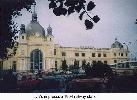 Having
sent a few electronic postcards to friends and family, I return to the
Hotel George around 1300, collect my things, and take a taxi to Lviv's
magnificent 1904 railway station. Miscommunicating the term "railway
station" to the driver results in my having to turn to a selection
of prints taken from the Lviv homepage of the Institute
for Condensed Matter Physics (http://Alpha.ICMP.Lviv.UA:1997/images)
maintained by Alexander Yakhnych. Pointing to a shot of the railway station,
the driver readily exclaimed "Ah, vokzal" and before long, we
were on our way.
Having
sent a few electronic postcards to friends and family, I return to the
Hotel George around 1300, collect my things, and take a taxi to Lviv's
magnificent 1904 railway station. Miscommunicating the term "railway
station" to the driver results in my having to turn to a selection
of prints taken from the Lviv homepage of the Institute
for Condensed Matter Physics (http://Alpha.ICMP.Lviv.UA:1997/images)
maintained by Alexander Yakhnych. Pointing to a shot of the railway station,
the driver readily exclaimed "Ah, vokzal" and before long, we
were on our way.
Boarding the train for Yaremcha I found it lacking in comfort, even by East European standards. A hard berth was partly compensated for by an old mattress discovered in the upper reaches of the compartment, though a dirty window prevented me almost altogether from seeing outside. Beginning to feel feverish, I prefer to fall asleep anyway and pulling on an extra layer of clothing, my attempts to drop off prove short-lived as the in-train radio forces me to put up with the latest in European-techno. Despite being joined by a young Ukrainian couple heading for Ivano-Frankivsk (some 4 hours from Lviv), we exchange little conversation and so roll slowly on to Yaremcha in silence under increasingly low cloud and the threat of rain. Beginning also to weigh heavily upon my mind is the daunting question: where do I sleep once I arrive in Yaremcha.
Reaching Yaremcha at 2000, I was relieved to be met by two gold-toothed babooshkas (Ukrainian for "grandmother"), both of them keen to offer accommodation for the night. 20 USD seemed to be the going the rate for two nights and given my apathy to look elsewhere, I accepted the offer at once. However, perhaps taken aback by my immediacy, she paused as if to contemplate my suitability as a lodger before making a final (and generous) offer of 10 USD for three nights. Arriving at her home, which up until a few years ago, was probably one of the more elegant in Yaremcha (owing to the large number of brick houses now being built), she shows me the outdoor toilet (housed to the rear with the chicken shed), the house's single tap, and by virtue of some steep wooden steps gingerly attached to the side of her house, the bedrooms. Between them, some 7 or 8 beds are available and so it seems she is more than accustomed to regularly picking up travellers. In fact, a quick calculation reveals she probably makes more money in one day than the pension she receives for one month (about 2 USD). That is, assuming her guests are Westerners. Local Ukrainian travellers wouldn't or couldn't pay more than a token (or as a Ukrainian might say, "symbolic") sum for a night's rest.
Over tea and dry bread we somehow manage to discuss the state of the weather and also the chances of hiring a taxi over the next few days in order that I can visit local places of interest such as Kosiv, Kuty and Vorokhta. However, as I quickly learn, there are few taxi drivers in Yaremcha and so I am forced to consider the alternatives. Depending on the weather and my own state of health, these include hitch-hiking, relying on the public transport (though services in these parts run infrequently at best), or hiking in and around Yaremcha. Too tired to consider these possibilities further, rest seems paramount and so I head for bed.
| Top of page |
DAY 4: Thursday 22 August
click for full size
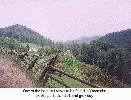 Yaremcha
- Waking early after a second near sleepless night to further stomach cramps
and a desire (still) to regularly visit the toilet, my disappointment at
spending another day inconvenienced could only be resolved by an improvement
in the weather. Taking a look out of the window, however, dark grey rain
clouds continued to conceal what I imagined were beautiful mountains covered
with lush green pastures and tall firs, blanketed in golden sunshine. Heading
downstairs, I found the babooshka talking to a young man who by a stroke
of luck, wanted to offer his car and services for the day. Since this could
prove a useful alternative to hiking locally and constantly avoiding the
rain showers, I mention travelling to Kuty and Vorokhta, the former renowned
for its natural beauty, while the latter, for two rather quaint churches,
the newer painted yellow complete with checkerboard domed roof. Looking
at me blankly, however, the driver simply asked whether I spoke Ukrainian
and then Polish. Replying I understood neither, I tried pointing to the
places on a map, but again to no avail. Giving up temporarily, I decided
to pay a visit to the toilet but by the time I returned, the stranger had
disappeared and with that it seemed my only chance of a taxi.
Yaremcha
- Waking early after a second near sleepless night to further stomach cramps
and a desire (still) to regularly visit the toilet, my disappointment at
spending another day inconvenienced could only be resolved by an improvement
in the weather. Taking a look out of the window, however, dark grey rain
clouds continued to conceal what I imagined were beautiful mountains covered
with lush green pastures and tall firs, blanketed in golden sunshine. Heading
downstairs, I found the babooshka talking to a young man who by a stroke
of luck, wanted to offer his car and services for the day. Since this could
prove a useful alternative to hiking locally and constantly avoiding the
rain showers, I mention travelling to Kuty and Vorokhta, the former renowned
for its natural beauty, while the latter, for two rather quaint churches,
the newer painted yellow complete with checkerboard domed roof. Looking
at me blankly, however, the driver simply asked whether I spoke Ukrainian
and then Polish. Replying I understood neither, I tried pointing to the
places on a map, but again to no avail. Giving up temporarily, I decided
to pay a visit to the toilet but by the time I returned, the stranger had
disappeared and with that it seemed my only chance of a taxi.
Somehow I preferred the idea of hiking in and around Yaremcha alone anyway. Believing mistakenly that staying within the vicinity would afford me good access to restaurants, tourist spots and perhaps even a museum, I couldn't have been more wrong. Heading into town, my first stop might have been the grocery store, were it not for the fact that nothing opened until 9 o'clock. Deciding to walk to Dora, a small village some three kilometres north of Yaremcha, I head off in search of its 17th century wooden Hutsul church. Hutsul is the name given to perhaps the most colourful group of Ukrainians, who, historically a fiercely independent group of people and skilled artisans, are the descendants of an ancient Slavic tribe that eventually mixed with Romanians and Hungarians. According to one theory, the name Hutsul comes from a Romanian word " Hot'ul" meaning brigand and should immediately tell one something about their characteristics. They are in fact a tough, not overly friendly, self-confessed hard drinking but hard working people. As for the architecture, wooden churches and theatres, houses (with decorative interiors as well as exteriors), rail-fences and even intricately detailed bus-shelters are all unique to the region.
click for full size
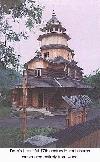 Reaching
Dora after little over half an hours walk, the church itself lies just
off the main road and is unlike anything I have ever seen before. Constructed
entirely from wood, even the roof is made from carefully cut small wooden
tiles. The interior decoration is marked most noticeably by a large wooden
lamp hanging from the centre of the ceiling, and at the end of its twenty
or so arms are small decorative bulbs. Each arm is adorned by small wooden
baubles and beads. Looking around the warm and cozy interior, draped over
the walls one can also find hand embroidered teacloths and tablecloths,
each with their own unique designs. My awe is cut short some moments later
when the church begins to fill with locals for what I imagine is morning
mass. Hutsuls are a devoutly Christian people, who, with the rest of Western
Ukraine, similarly converted to Ukrainian Catholicism in the 16th and 17th
centuries. Feeling somewhat out of place, I don't stay long enough to enjoy
the rites and customs of a traditional Uniate service.
Reaching
Dora after little over half an hours walk, the church itself lies just
off the main road and is unlike anything I have ever seen before. Constructed
entirely from wood, even the roof is made from carefully cut small wooden
tiles. The interior decoration is marked most noticeably by a large wooden
lamp hanging from the centre of the ceiling, and at the end of its twenty
or so arms are small decorative bulbs. Each arm is adorned by small wooden
baubles and beads. Looking around the warm and cozy interior, draped over
the walls one can also find hand embroidered teacloths and tablecloths,
each with their own unique designs. My awe is cut short some moments later
when the church begins to fill with locals for what I imagine is morning
mass. Hutsuls are a devoutly Christian people, who, with the rest of Western
Ukraine, similarly converted to Ukrainian Catholicism in the 16th and 17th
centuries. Feeling somewhat out of place, I don't stay long enough to enjoy
the rites and customs of a traditional Uniate service.
Emerging from the church to the sound of heavier rain, I find myself walking some five kilometers further up the road in search of Deliatyn 's supposedly "finer example of Hutsul architecture". Upon entering the village, to my initial disappointment I find the restaurant housed within the "Hotel Zakarpattia" has been closed for some time. Instead I am referred to the neighbouring "Produkty" (state run food store), which more drab than the weather, offers an uninspired range of tinned meats, bottled fruits, sour milk, and stale bread. Leaving empty handed, I purchase a kilo of tomatoes from a makeshift market-stall accommodated in the boot of a beat-up old Zhiguli standing on the side of the road. Even a couple of tomatoes, however, prove indigestible, and, walking the length of the town, I give up both my search for food and Deliatyn's Hutsul "gem" which sadly is nowhere to be found, and hitch a ride back to Yaremcha. Although hitch-hiking, for safety's sake more than any other is not generally recommended in Ukraine, it was clearly preferable to the 2 hours long walk back. Upon leaving Deliatyn, I was picked up by a middle aged Ukrainian with whom I exchanged a little polite conversation before arriving back in Yaremcha some ten minutes later. A few dollars gratuity certainly doesn't go amiss at times like these, but preoccupied with other matters I overlook this small gesture entirely.
click for full size
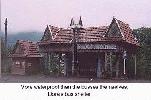 Intent
on finding a toilet and shelter from the wet weather, I recall the picture
of a Hutsul restaurant from the 1995 edition of Ukraine; A Tourist Guide
by Zinkewych and Hula. A brief inquiry at the Poshta (Post Office) refers
me a kilometre and a half down the road to the banks of the Prut and a
stone's throw from a spot where locals gather to sell traditional crafts.
The restaurant itself is a remarkable example of Hutsul architecture and
from its semi-circular hall inside, a 180 degree panorama of the valley
and hillsides through its tall windows decorated with carved wooden shutters
can be seen (pending clearer skies of course). Hard chairs and solid wooden
tables, intricately carved pillars, and delicate lanterns bring charm to
this otherwise cold and disconcertingly empty restaurant.
Intent
on finding a toilet and shelter from the wet weather, I recall the picture
of a Hutsul restaurant from the 1995 edition of Ukraine; A Tourist Guide
by Zinkewych and Hula. A brief inquiry at the Poshta (Post Office) refers
me a kilometre and a half down the road to the banks of the Prut and a
stone's throw from a spot where locals gather to sell traditional crafts.
The restaurant itself is a remarkable example of Hutsul architecture and
from its semi-circular hall inside, a 180 degree panorama of the valley
and hillsides through its tall windows decorated with carved wooden shutters
can be seen (pending clearer skies of course). Hard chairs and solid wooden
tables, intricately carved pillars, and delicate lanterns bring charm to
this otherwise cold and disconcertingly empty restaurant.
Hutsul food is generally at its best when served as plain and simple home cooking. Among the most common dishes are Borsch (no "t" at the end as in Russian), varennyky (the same as Hungarian galuska) with potatoes or kapusta (sauerkraut) and/or fruit, holubtsi (stuffed cabbage with rice and meat and/or mushrooms) and pliatsky or mlyntsi (potato pancake), with kobasa (pork sausage). Since Hutsuls are also sheep herders, some lamb may turn up on the ever-elusive menu, perhaps prepared Russian style. For dessert, nalysnyky (palacsinta or crepes) is a favourite.
The restaurant's WC proved to be a nauseating experience that almost left me once again without any appetite. Unpleasant toilet facilities are common in Ukraine, even in top-class restaurants, but these must have ranked among the worst. Entering with toilet tissue in hand, I was forced to fumble around in the darkness, first for the lightswitch (which inevitably didn't work), followed by a seatless, unrinsable toilet. Only luck would have it I was carrying a pocket-sized torch! Returning to my table minutes later, in contrast to that unpleasant experience, I was served a surprisingly pleasant salad followed by a dish of minced pork, fried in a light batter with mushroom sauce and potatoes. The hot blackcurrant tea that followed was superb and with the rain still persisting, I reserved my seat for a further 45 minutes by ordering several more cups of the same. The total bill came to approximately 500,000 Kupons or 2.5 USD.
Over a narrow bridge that crosses the River Prut lies a small yard where under the watchful eyes of the local police (keen to ensure that Kupons and not dollars change hands), local Hutsuls vie for the occasional tourist passing through. Typical offerings are traditional crafts and clothing that include ceramic pottery, carved boxes and plates, pysanky (traditional Ukrainian decorated eggs) and a range of leather and fur goods. The regional Hutsul folk costume is a favourite, the hand embroidered traditional shirt being topped with a leather vest known as a "kiptar" or a heavy felt jacket called a "serdak". Personal treasures included a carved wooden chess set for 20 USD, wooden jewellry, cooking utensils, a deep red stained flute/recorder and for 20 USD a traditional Ukrainian shirt.
The rain holding off for an hour or two at last affords me enough time for a brief walk up the hillside, short also because the day is drawing to a close. However, even the 1:200,000 scale Ukrainian walkers' maps (cca. 1993) are not sufficiently detailed when it comes to hill walking, and as a result I spend the next twenty minutes following a stream along its course until eventually I find a recognizable spot on the map. From here I head through one of the many valleys to be found in this beautiful part of Yaremcha and before long am within close range of low cloud, tree covered slopes and waterlogged grass. Walking among large cottages from which smoke already bellows, I begin to wonder what life must be like here in the depths of winter (where temperatures can drop well below -30 degrees Celsius) with snow piled high around one's door isolated from the town, now a good 45 minutes below.
With blue skies appearing and the sun beginning to shine, however, I cast my mind to tomorrow, and wonder whether a second day might after all offer the opportunity, pending my condition (stomach cramps continuing unabated), to climb "Hora Hoverlia", at 2061m the highest peak in the Carpathians. If not, I begin to envisage an early departure for the more comforting environment of Uzhhorod, lying close to the Hungarian and Slovak borders.
Returning to the centre of town, the Poshta dutifully provided the last adventure of the day. Being the only place in Yaremcha from where an international call can be made, it also happens to be one of the busiest places, 24 hours of the day. Requesting the not overly friendly clerk on the other side of the glass window connect a call to Hungary for me, I pass her a piece of paper with the required number scribbled upon it. Largely owing to the poor telecommunications infrastructure in both Ukraine and Hungary, unfortunately, getting through proved tiresome and with every attempt to get a connection failing, the clerk insisted I pay the operator fees before repeat dialling the number. Eventually making a successful connection, I was then taken by surprise some minutes later by a total power blackout. Strange, I muse to myself. Before Chornobyl (the Ukrainian spelling for Chernobyl) was constructed, Ukraine suffered from regular power shortages that made life at the very least inconvenient, and meant business and industry could scarcely function without the threat of constant interruption. Now that Chornobyl is operational, the problem of power shortages like these are supposed to have been alleviated. However, with pressure mounting from the international community for the closure of the power station (in an attempt to avoid the threat of further nuclear accidents like that which occurred on 26 April 1986), Ukraine it seems is set to turn the clock back. A suitable energy alternative (that is not damaging to the environment) needs to be found, but with West European countries so far failing to come up with one that is cost-effective, the real issue is what commitment is the West willing to show in assisting Ukraine find (and fund) this alternative?
Power, in fact, went down across the whole of Yaremcha, as well as the water supply. Finishing up my call in darkness, the bill amounted to approximately 4 USD for the 7 minutes, and 50 cents for the failed connections. Arriving home, the only way it seemed to get the elusive night's sleep I by now very much needed was to remove the blankets and mattresses from the bed and place them on the hard wooden floor. Sleeping under three duvets I did indeed sweat the fever out, and by the following morning had already began to feel much better.
| Top of page |
DAY 5: Friday 23 August
Yaremcha - Uzhhorod. But waking to the sound of further heavy rain, there seemed little point staying any longer in Yaremcha, and with the immediate attractions now visited I shortly found myself heading to the railway station and the 0900 train for Rakhiv. Requesting "Odin bilet do Rakhiv" (one ticket to Rakhiv) from the travel clerk, I was charged just 300,000 Kupons or 1.5 USD for the ticket. Being a "local" service, the train was already full upon its arrival in Yaremcha, and boarding with a woman and her three chickens should have told me all I needed to know about rail travel in this particular region. Without even letting the other passengers alight, my "companion" launched herself headfirst into the overcrowded train. Following in her footsteps, it wasn't surprising to find that the train offered precious little space even in the way of standing-room. With condensation dripping from the windows, a temperature that must have been fast approaching 30 degrees Celsius, and the air bordering on maximum humidity, all this made for a rather uncomfortable start to what was to be a long four hour journey. Having hoped to take pictures from the train, it instead seemed more fitting to take pictures of what could only be described as the melee inside. Seeing past the huge sweating bodies in front of me, I manage just a single picture. Given the surprise this causes, however, without wishing to attract further attention, it makes more sense to stop.
The journey to Rakhiv was slow and the fine views I had hoped to see remained firmly enshrouded behind mountain mists and low cloud, confirming that leaving the mountains behind made more sense. Helping to pass the time were those young and old who every so often walked the length of the train selling anything from sunflower seeds to socks, and sweets to sandwiches. Most notable however was the interest accorded to one old man who sold cheap gold necklaces for 100,000 Kupons. Neither the babooshkas nor the young girls could resist these cheap imitations which seemed to carry a fashion value far higher than anything else most other people on the train were wearing.
Arriving in Rakhiv at 1300, barely enough time could be found to dash across the station and pick up the only bus of the day destined for Uzhhorod. Complete with leaking roof, we journeyed our way across and out of the Carpathians, following for much of the way the River Tysa (Tisza in Hungarian) which also forms part of Ukraine's western border with Romania. Crossing the hilltops and plains toward Mukacheve, the skies remained a deep blue-grey that in the path of the now shining sun, looked rather like the stormy scenes captured on the canvas of an old Dutch master. Arriving in Uzhhorod at 1800, my first port of call was to be the Hotel Svitanok on the north side of the town, one that is supposedly well-suited (according to Lonely Planet) to a traveller's budget. Requesting a single room without bathroom, I was naturally taken aback to be told the charge would be 32 USD. Arguing that for this amount I could stay in Lviv for two nights, through the assistance of a Ukrainian/Hungarian speaking Slovak, I was subsequently offered the more reasonable price of 16 USD. While the hotel room eventually turned out to be a comfortable double with the luxury of an en-suite bathroom, the shower could only dispense luke-warm water at best.
With the Hotel situated an easy ten minutes walk from the centre of town, I spent a lazy evening enjoying the sites of Uzhhorod combined with a visit to the outdoor Museum of Popular Architecture. Lying adjacent to Uzhhorod's historic 15th century castle, it was originally built to defend the then Hungarian (and Ukrainian) population against the Turkish invasions. The Hutsul church, St. Michael's, which was moved from Mukacheve in 1974, is the highlight of the Museum and goes some way in compensating for the Hutsul treasure I was unlucky enough not to find in rain-drenched Deliatyn just a day earlier. Sensing a holiday atmosphere on the eve of independence day celebrations, I settle down a whisper away from the hum of Uzhhorod's (in the language of ancient Ukraine "horod" means "city", ergo, "City on the Uzh") old town square and overlooking the River Uzh watch the sun set slowly over pizza and a beer.
| Top of page |
DAY 6: Saturday 24 August
click for full size
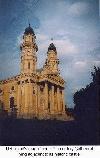 Uzhhorod
- Lying close to the Slovak border (in fact just four kilometers away),
Uzhhorod enjoys a great deal of cross-border trade with its neighbours
in the new "West", reviving to some degree the strong links that
formerly existed within the region. Until the end of the First World War,
Uzhhorod (or Ungvar as it was then known) had been a Hungarian town for
almost a thousand years, but with the collapse of the Austro-Hungarian
Empire in 1919, the whole of Zakarpattia (including Uzhhorod), had been
transferred to newly created Czechoslovakia. Remaining under Czechoslovak
administration until 1938, the Hungarians retook Ungvar and Zakarpattia
on the eve of World War Two, only to be driven out by the Nazi's and then
the Red Army in 1945, when the region was absorbed as a part of Ukraine
into the USSR. With Ukraine emerging as an independent state in 1991 following
the break up of the FSU, Uzhhorod once again began to adopt a more European
flavour, something which today is clearly visible upon the faces of young
people and in the fashions being modelled. Not unfamiliar to any part of
Central Europe, a Nike shop has now opened in the centre of Uzhhorod, predictably
a stone's throw from the old town square, while the town's main attraction,
a huge bustling flea market, brings together all walks of life including
Slovaks, Poles, Ukrainians and Hungarians selling western merchandise at
discount prices. Lying close to the Avanhard Stadium, the market offers
everything from tracksuits and training shoes, to underwear and leather
jackets, as well as books and magazines, kitchen utensils, kids' toys and
even puppies. Personal bargains, besides bootleg CDs for 5 USD a piece,
included an Ajax football shirt (from Turkey apparently), kids clothes
(from East Asia I suppose) and some Italian designer shoes for toddlers.
The market is indeed worth a visit and in fact I spent the best part of
the morning enjoying the sights and sounds of this multi-cultural melting
pot.
Uzhhorod
- Lying close to the Slovak border (in fact just four kilometers away),
Uzhhorod enjoys a great deal of cross-border trade with its neighbours
in the new "West", reviving to some degree the strong links that
formerly existed within the region. Until the end of the First World War,
Uzhhorod (or Ungvar as it was then known) had been a Hungarian town for
almost a thousand years, but with the collapse of the Austro-Hungarian
Empire in 1919, the whole of Zakarpattia (including Uzhhorod), had been
transferred to newly created Czechoslovakia. Remaining under Czechoslovak
administration until 1938, the Hungarians retook Ungvar and Zakarpattia
on the eve of World War Two, only to be driven out by the Nazi's and then
the Red Army in 1945, when the region was absorbed as a part of Ukraine
into the USSR. With Ukraine emerging as an independent state in 1991 following
the break up of the FSU, Uzhhorod once again began to adopt a more European
flavour, something which today is clearly visible upon the faces of young
people and in the fashions being modelled. Not unfamiliar to any part of
Central Europe, a Nike shop has now opened in the centre of Uzhhorod, predictably
a stone's throw from the old town square, while the town's main attraction,
a huge bustling flea market, brings together all walks of life including
Slovaks, Poles, Ukrainians and Hungarians selling western merchandise at
discount prices. Lying close to the Avanhard Stadium, the market offers
everything from tracksuits and training shoes, to underwear and leather
jackets, as well as books and magazines, kitchen utensils, kids' toys and
even puppies. Personal bargains, besides bootleg CDs for 5 USD a piece,
included an Ajax football shirt (from Turkey apparently), kids clothes
(from East Asia I suppose) and some Italian designer shoes for toddlers.
The market is indeed worth a visit and in fact I spent the best part of
the morning enjoying the sights and sounds of this multi-cultural melting
pot.
click for full size
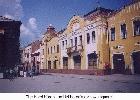 Uzhhorod's
fine buildings are reminiscent of those to be found in Eger or Veszprem
in Hungary, though its tidy streets could easily be mistaken for the streets
of Bratislava. The Hotel Korona on the old town square (bearing the name
of both Slovak and Czech national currencies), is currently undergoing
renovations and once completed, will undoubtedly be the place to stay.
And among Uzhhorod's fine churches, one will find irresistibly cute the
candy-coloured Russian Orthodox, while the impressive twin-towered 17th
century Cathedral up on the castle hill and huge red brick building on
the east side of the old town square, formerly a Jewish synagogue, prove
attractions also not to be missed. Fine museums worth a visit include the
Transcarpathian Art Museum at Ploscha Zhupanatska and the Transcarpathian
Museum of Local Lore housed within the grounds of Uzhhorod Castle.
Uzhhorod's
fine buildings are reminiscent of those to be found in Eger or Veszprem
in Hungary, though its tidy streets could easily be mistaken for the streets
of Bratislava. The Hotel Korona on the old town square (bearing the name
of both Slovak and Czech national currencies), is currently undergoing
renovations and once completed, will undoubtedly be the place to stay.
And among Uzhhorod's fine churches, one will find irresistibly cute the
candy-coloured Russian Orthodox, while the impressive twin-towered 17th
century Cathedral up on the castle hill and huge red brick building on
the east side of the old town square, formerly a Jewish synagogue, prove
attractions also not to be missed. Fine museums worth a visit include the
Transcarpathian Art Museum at Ploscha Zhupanatska and the Transcarpathian
Museum of Local Lore housed within the grounds of Uzhhorod Castle.
click for full size
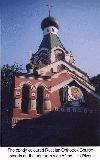 Independence
day celebrations turn out to be less festive than one might expect for
a country keen to shake off Moscow's formerly firm hold, perhaps a result
of Zakarpattia's own independent line from Kyiv and the fact that a large
number of western Ukrainians are Rusyns (Ruthenians) as opposed to Ruski
(Russians). Nevertheless, the younger generations appear content with the
festivities, and during the afternoon, a combination of scout groups and
girl guides could be seen singing and clapping their way across the town.
Later in the evening, the older locals gathered in the old town square
to listen to the mayor of Uzhhorod, followed by entertainment from a young
rapper clearly making a name for himself on the local music scene, at least
judging by the number of young onlookers and admirers.
Independence
day celebrations turn out to be less festive than one might expect for
a country keen to shake off Moscow's formerly firm hold, perhaps a result
of Zakarpattia's own independent line from Kyiv and the fact that a large
number of western Ukrainians are Rusyns (Ruthenians) as opposed to Ruski
(Russians). Nevertheless, the younger generations appear content with the
festivities, and during the afternoon, a combination of scout groups and
girl guides could be seen singing and clapping their way across the town.
Later in the evening, the older locals gathered in the old town square
to listen to the mayor of Uzhhorod, followed by entertainment from a young
rapper clearly making a name for himself on the local music scene, at least
judging by the number of young onlookers and admirers.
With the evening drawing to a close, I stumble upon what appears to be a newly opened pizza parlour not five minutes walk southwest of Ploscha Petefi. Modern in design and youthful in atmosphere, it offers a full a la carte menu, polite young staff and even credible toilet facilities. For 400,000 Kupons or a little over 2 USD, a Mexican pizza and beer was enjoyed, but with time slipping by fast, before long it was time to depart for the station and a train bound for Mukacheve. From here I hoped to pick up the Lviv-Budapest "Tisza Express".
With tiredness rapidly taking a hold, I boarded the train at 2155, having bought the ticket for little more than 3 USD. Mistakenly, I had understood it would be one of the local 45 minute "shuttles" that supposedly ran between Uzhhorod and Mukacheve. It wasn't, and instead I was subjected to a tour of the Ukrainian border regions, picking up on the way more cross-border traders than I could ever have imagined existed - enough at the first stop alone Chop) for most outsiders to be put off rail travel in Ukraine. Stopping twice again before eventually reaching Mukacheve at 0015, the train continued its long journey on to Kharkiv, some 900 kilometres east of Uzhhorod and Ukraine's northeastern border with Russia. Small wonder, I suppose, jaded looking travellers were carting crates of margarine, fruit, soap and other luxuries to the country's more remote parts.
Heading for the waiting room guarded by three solid bronze sculptures of hard-working socialist man and woman, I find it considerably cleaner and more modern than most Ukrainian railway stations. Illustrated with pictures of children playing and learning, supposedly depicting the strengths of the socialist system to educate (or indoctrinate) from an early age, I spend the next three hours reading and enjoying the good coffee served by the station's new "non-stop" cafeteria outside, itself decorated with beautifully carved Hutsul woodwork. Even here in the outer reaches of the Carpathians, it seems these Ukrainian highlander's traditions pervade every aspect of life.
| Top of page |
Return to Budapest: Sunday 25 August
Mukacheve-Budapest. Upon boarding the Lviv-Budapest train at 0325 after what seemed like hours of waiting, I was told by the conductor I couldn't bed down since the border lay only half an hour away. In fact, half an hour turned out to be an hour and to my misfortune, it was way past 8 am before any real opportunity again arose to get some sleep. Being handed the Deklaratsia once again for completion, I began to wonder what questions might arise from customs control concerning my bargain purchases down on the Avanhard Flea Market or the rather "off-the-record" hotel accommodation in Uzhhorod. Figuring I'll bluff I lost the receipts or they were simply not given in the first place, the inspector in fact took only one look at the form before authorising it and asked simply that I present my luggage. A further four hours of bleary eyed formality followed including those infamous wheel changes before we rolled slowly across Hungary's border and sun-drenched Puszta for Budapest. With bright sunshine now also flooding my compartment, I fast gave up on the idea of getting any sleep, and instead looked forward to being home again, falling asleep in my own bed, and enjoying a decent shower. Most important of all of course, I looked forward to seeing my wife-to-be and 21 month old son. Needless to say, it wasn't long before I had all three.
click for full size
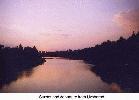 Whilst
glad to be home, in reflecting upon my journey, both Lviv and Uzhhorod
had more than lived up to my expectations. The only blemish on what otherwise
proved to be a perfect adventure was the bad weather and sickness experienced
from an unfortunate visit to the wrong restaurant. Had I been luckier,
the mountains would surely have proved spectacular and rounded off another
memorable trip into the unknown. My only fear now is that upon returning
to this enchanting land, towns such as Lviv will have been overrun by Western
tourists and more modern cafes than I care to imagine. For better or for
worse? I leave that for you to decide once you have made your acquaintance
with the beautiful region that is Western Ukraine.
Whilst
glad to be home, in reflecting upon my journey, both Lviv and Uzhhorod
had more than lived up to my expectations. The only blemish on what otherwise
proved to be a perfect adventure was the bad weather and sickness experienced
from an unfortunate visit to the wrong restaurant. Had I been luckier,
the mountains would surely have proved spectacular and rounded off another
memorable trip into the unknown. My only fear now is that upon returning
to this enchanting land, towns such as Lviv will have been overrun by Western
tourists and more modern cafes than I care to imagine. For better or for
worse? I leave that for you to decide once you have made your acquaintance
with the beautiful region that is Western Ukraine.
For travellers wishing to visit Ukraine, trains leave daily from Budapest's Keleti Palyaudvar at 1615 and arrive in Lviv at 0636. Trains returning to Budapest depart Lviv at 2207 and reach Keleti at 1157. II class return tickets including couchette are available for 10,300 HUF (approximately 70 USD). Reservations must be made in advance, however, the return booking can only be made once in Ukraine. Visas can be obtained for 50 USD from the Ukrainian Embassy based in Nogradi utca, Budapest XII, Tel: 156 8697. 2 passport sized photos, a valid passport and an original letter of invitation are required. Letters of invitation should include the following information: Name of visitor, Date of Birth, Place of Birth, Passport Number, Date of Issue, Place of Issue, and Date of Expiration. Visas can usually be collected later on the day of application, or within 5 days for the slightly lower charge of 30 USD.
Jerome Simpson, Budapest, November 1996
Hanya Krill of Hunter College, City University of New York, also contributed to this report.
Many of the historical facts and details concerning Ukraine and its architecture were taken from Lonely Planet's 1996 Travel survival Kit for Russia, Ukraine and Belarus. Lonely Planet can be found on the Internet under http://www.lonelyplanet.com/.
All materials herein are copyrighted by the author. Permission is granted strictly for non-profit distribution with the following conditions: the article is to be distributed in its entirety with no changes to text or images, and credit must be given to Jerome Simpson. Anyone wishing to disseminate for uses other than those expressly defined above must first request and receive permission from the author. Email: Jerome@fs2.bp.rec.hu